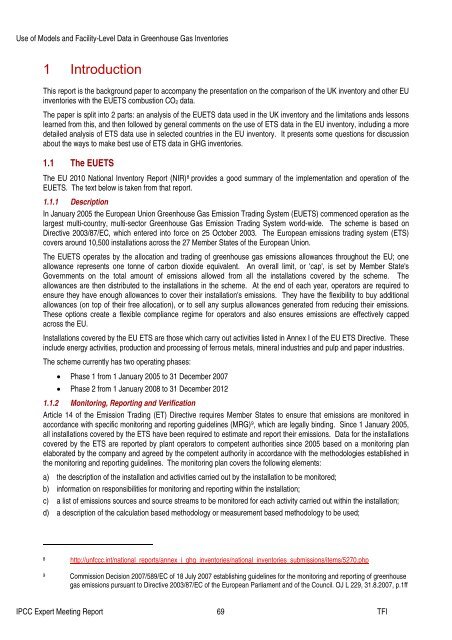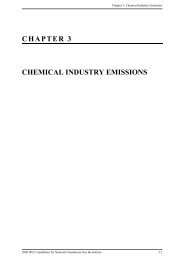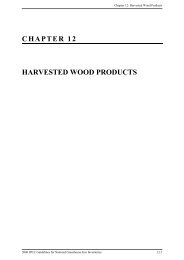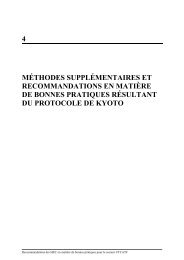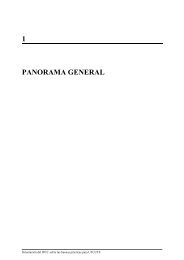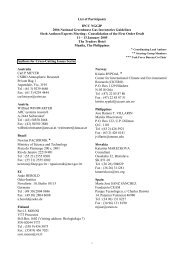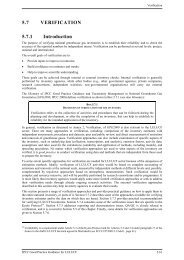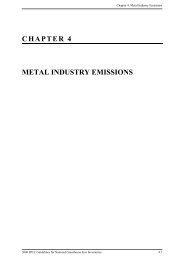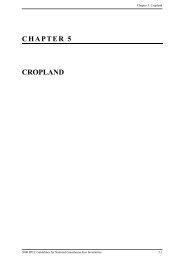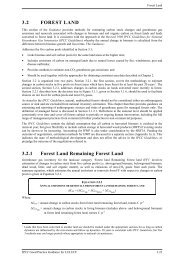Use of Models and Facility-Level Data in Greenhouse Gas Inventories
Use of Models and Facility-Level Data in Greenhouse Gas Inventories
Use of Models and Facility-Level Data in Greenhouse Gas Inventories
You also want an ePaper? Increase the reach of your titles
YUMPU automatically turns print PDFs into web optimized ePapers that Google loves.
<strong>Use</strong> <strong>of</strong> <strong>Models</strong> <strong>and</strong> <strong>Facility</strong>-<strong>Level</strong> <strong>Data</strong> <strong>in</strong> <strong>Greenhouse</strong> <strong>Gas</strong> <strong>Inventories</strong><br />
1 Introduction<br />
This report is the background paper to accompany the presentation on the comparison <strong>of</strong> the UK <strong>in</strong>ventory <strong>and</strong> other EU<br />
<strong>in</strong>ventories with the EUETS combustion CO 2 data.<br />
The paper is split <strong>in</strong>to 2 parts: an analysis <strong>of</strong> the EUETS data used <strong>in</strong> the UK <strong>in</strong>ventory <strong>and</strong> the limitations <strong>and</strong>s lessons<br />
learned from this, <strong>and</strong> then followed by general comments on the use <strong>of</strong> ETS data <strong>in</strong> the EU <strong>in</strong>ventory, <strong>in</strong>clud<strong>in</strong>g a more<br />
detailed analysis <strong>of</strong> ETS data use <strong>in</strong> selected countries <strong>in</strong> the EU <strong>in</strong>ventory. It presents some questions for discussion<br />
about the ways to make best use <strong>of</strong> ETS data <strong>in</strong> GHG <strong>in</strong>ventories.<br />
1.1 The EUETS<br />
The EU 2010 National Inventory Report (NIR) 8 provides a good summary <strong>of</strong> the implementation <strong>and</strong> operation <strong>of</strong> the<br />
EUETS. The text below is taken from that report.<br />
1.1.1 Description<br />
In January 2005 the European Union <strong>Greenhouse</strong> <strong>Gas</strong> Emission Trad<strong>in</strong>g System (EUETS) commenced operation as the<br />
largest multi-country, multi-sector <strong>Greenhouse</strong> <strong>Gas</strong> Emission Trad<strong>in</strong>g System world-wide. The scheme is based on<br />
Directive 2003/87/EC, which entered <strong>in</strong>to force on 25 October 2003. The European emissions trad<strong>in</strong>g system (ETS)<br />
covers around 10,500 <strong>in</strong>stallations across the 27 Member States <strong>of</strong> the European Union.<br />
The EUETS operates by the allocation <strong>and</strong> trad<strong>in</strong>g <strong>of</strong> greenhouse gas emissions allowances throughout the EU; one<br />
allowance represents one tonne <strong>of</strong> carbon dioxide equivalent. An overall limit, or 'cap', is set by Member State's<br />
Governments on the total amount <strong>of</strong> emissions allowed from all the <strong>in</strong>stallations covered by the scheme. The<br />
allowances are then distributed to the <strong>in</strong>stallations <strong>in</strong> the scheme. At the end <strong>of</strong> each year, operators are required to<br />
ensure they have enough allowances to cover their <strong>in</strong>stallation's emissions. They have the flexibility to buy additional<br />
allowances (on top <strong>of</strong> their free allocation), or to sell any surplus allowances generated from reduc<strong>in</strong>g their emissions.<br />
These options create a flexible compliance regime for operators <strong>and</strong> also ensures emissions are effectively capped<br />
across the EU.<br />
Installations covered by the EU ETS are those which carry out activities listed <strong>in</strong> Annex I <strong>of</strong> the EU ETS Directive. These<br />
<strong>in</strong>clude energy activities, production <strong>and</strong> process<strong>in</strong>g <strong>of</strong> ferrous metals, m<strong>in</strong>eral <strong>in</strong>dustries <strong>and</strong> pulp <strong>and</strong> paper <strong>in</strong>dustries.<br />
The scheme currently has two operat<strong>in</strong>g phases:<br />
• Phase 1 from 1 January 2005 to 31 December 2007<br />
• Phase 2 from 1 January 2008 to 31 December 2012<br />
1.1.2 Monitor<strong>in</strong>g, Report<strong>in</strong>g <strong>and</strong> Verification<br />
Article 14 <strong>of</strong> the Emission Trad<strong>in</strong>g (ET) Directive requires Member States to ensure that emissions are monitored <strong>in</strong><br />
accordance with specific monitor<strong>in</strong>g <strong>and</strong> report<strong>in</strong>g guidel<strong>in</strong>es (MRG) 9 , which are legally b<strong>in</strong>d<strong>in</strong>g. S<strong>in</strong>ce 1 January 2005,<br />
all <strong>in</strong>stallations covered by the ETS have been required to estimate <strong>and</strong> report their emissions. <strong>Data</strong> for the <strong>in</strong>stallations<br />
covered by the ETS are reported by plant operators to competent authorities s<strong>in</strong>ce 2005 based on a monitor<strong>in</strong>g plan<br />
elaborated by the company <strong>and</strong> agreed by the competent authority <strong>in</strong> accordance with the methodologies established <strong>in</strong><br />
the monitor<strong>in</strong>g <strong>and</strong> report<strong>in</strong>g guidel<strong>in</strong>es. The monitor<strong>in</strong>g plan covers the follow<strong>in</strong>g elements:<br />
a) the description <strong>of</strong> the <strong>in</strong>stallation <strong>and</strong> activities carried out by the <strong>in</strong>stallation to be monitored;<br />
b) <strong>in</strong>formation on responsibilities for monitor<strong>in</strong>g <strong>and</strong> report<strong>in</strong>g with<strong>in</strong> the <strong>in</strong>stallation;<br />
c) a list <strong>of</strong> emissions sources <strong>and</strong> source streams to be monitored for each activity carried out with<strong>in</strong> the <strong>in</strong>stallation;<br />
d) a description <strong>of</strong> the calculation based methodology or measurement based methodology to be used;<br />
8 http://unfccc.<strong>in</strong>t/national_reports/annex_i_ghg_<strong>in</strong>ventories/national_<strong>in</strong>ventories_submissions/items/5270.php<br />
9 Commission Decision 2007/589/EC <strong>of</strong> 18 July 2007 establish<strong>in</strong>g guidel<strong>in</strong>es for the monitor<strong>in</strong>g <strong>and</strong> report<strong>in</strong>g <strong>of</strong> greenhouse<br />
gas emissions pursuant to Directive 2003/87/EC <strong>of</strong> the European Parliament <strong>and</strong> <strong>of</strong> the Council. OJ L 229, 31.8.2007, p.1ff<br />
IPCC Expert Meet<strong>in</strong>g Report 69 TFI


